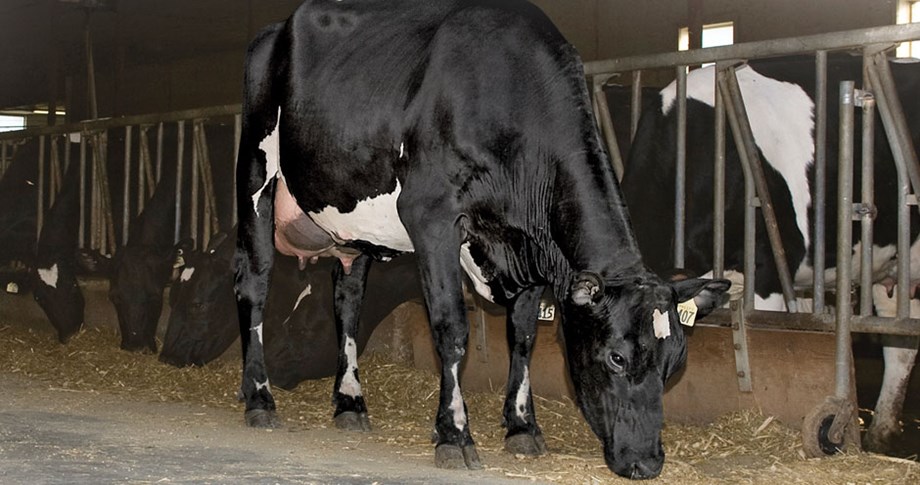The TwoPlus research study was initiated by an AI Industry group led by Gencor Inc., Westgen Inc., and EBI Inc, the Semex Alliance, and Geno Global, Norway, with support from an Agriculture Canada CanAdvance grant. It was called TwoPlus, as it was envisaged to be a two-breed rotational crossing program using Holsteins (HO) and Norwegian Reds (NRF).
Matings between Norwegian Red elite AI proven sires and purebred Holstein dams aimed at getting 20 NRF x HO heifers per herd in 60 or more herds. The total number of crossbred heifers was 1018 in 61 herds that were still on the project after 5 years. Immune responses of a subset of the NRF x HO and HO heifer calves and first lactation cows were also compared in a separate study. These results will be reported separately.
Calving ease
When the first calves by Norwegian Red sires began to arrive in 2006, the Canadian Dairy Network made an analysis of Calving Performance records in the herds that calved out both HO x HO matings and NRF x HO matings from January 2006 through October 2007, analyzing a total of 15,820 HO x HO calvings and 859 NRF x HO calvings.
The Norwegian Red service sires, when mated to Holstein yearling heifers gave 93% live calves at birth, vs. 88.1 % live calves when Holstein service sires were mated to yearling Holstein heifers, an advantage of 5.6 % more live calves.
Reproduction
The reproduction ability of the NRF x HO yearling heifers and their calving and reproductive performance in the first lactation were compared to their HO herd-mates in the project herds.
As yearling heifers, the NRF x HO heifers were first bred 7 days earlier than their HO herd mates, and their non-return rate was 81.8% compared to 76.6% for HO yearling heifers. Thus, the NFR x HO heifers had slightly fewer inseminations, and their interval from the first service to conception was about 2 days less than for HO heifers. Gestation length was 2 days shorter for NRF x HO heifers.
When the heifers calved for the first time, the NRF x HO heifers gave an 8.3% higher percentage of unassisted calvings than HO heifers, and a 5.3% lower stillbirth rate. This was likely due to the slightly smaller size of the calves compared to calves from HO heifers.
During the breedings in the first lactation, NRF x HO heifers had an 11.1% higher non-return rate, slightly fewer services, but a little longer intervals from calving to first service, and first service to conception than HO heifers. Their subsequent gestation lengths were essentially equal with no differences in calving ease or calf size, but NRF x HO heifers gave 4.3% lower stillbirth rates.
Survival
The CDN reported in 2007 that 5% more live NRF x HO calves were born alive from first calf HO heifers and 1% more were born from later parity HO cows in the TwoPlus study. In a herd with 30% heifers calving for the first time and 70% older cows calving, the advantage in extra live calves at birth is then 2.2%.
Survival of the NRF x HO female calves from birth to first breeding was about 6.8% higher than for Holstein female calves. Subsequently, survival of NRF x HO yearlings from first breeding to first calving was 10.9% more than HO yearlings. Combined that means from birth to first calving there were 20% more NRF x HO females remaining than HO females. This survival reflects liveability, desire to live, and fewer problems for the producer. There would be greater returns from the investment in the crossbreds than in the HO from the greater survival rate.
Production
Test day records for milk, fat, protein, and somatic cell score were analyzed for all NRF x HO heifers, in comparison to their Holstein herd mates in the project herds. Data were analyzed via a test day model similar to that for regular sire and cow genetic evaluations in Canada, but records were not adjusted for the impact of pregnancy on production.
NRF x HO heifers had slightly, but not significantly, lower yields of milk and protein, as well as slightly, but not significantly, higher yields of fat through 305 days, compared to their HO herd mates. Similarly, there was no significant difference between the NRF x HO heifers in their 305-day yields of milk and protein, with HO higher by 361 kg of milk and 2.6 kg protein, and NRF x HO higher by 2.5 kg of fat.
There were no significant differences between NRF x HO heifers and HO herd mates for somatic cell score throughout the lactation, although the NRF x HO crosses had lower SCS at the start and end of their lactations.
Conclusions
Results to date indicate that crossbreeding may be a profitable alternative for commercial dairies. A number of Canadian dairy breeds could complement the high-producing Canadian Holstein for health, reproduction, milk solids yield, survival, and vitality. The Norwegian Red breed has been effectively selected with a heavy emphasis on calving ease, calf liveability, female reproduction, health traits, udders and feet, and legs conformation, and solids yield for over 30 years.
Crossbreeding of purebred HO females to any other breed of sire will immediately reduce inbreeding levels to zero in the F1 cross and eliminate problems associated with inbreeding depression. However, crossbreeding, as a total package, can also provide financial benefits in terms of improved fertility, fewer calving problems, better disease resistance, higher survival, and no significant decrease in milk production. Choosing non-HO sires for crossing to HO females should use the same degree of care as choosing HO sires.
The report (link below) presents the advantages of using Norwegian Red genetics. Crossbred animals are not going to win in the show ring nor bring large prices for individual animals at auctions, but their performance may prove to be very profitable for commercial enterprises.
Canadian TwoPlus Project – full report (pdf)
Article from University of Guelph:
Crossbreeding Produces Healthier Cows
